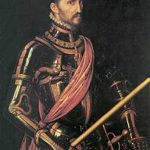Flavius Valerius Aurelius Constantinus was born around 274 AD. His was a patrician family in Rome and his father was Constantius I who died in the year 306, when our subject was thirty-two years old. He should have succeeded immediately, because the army declared him emperor, but there were, as always, complications; several other patricians rather thought they should rule, among them Licinius. Constantine showed consummate skill in staying alive, at the same time ‘removing’ the competition according to the ancient rules of the game.
By 314 he and Licinius had divided the empire between them, East and West but inevitably they came to blows and after a number of minor battles and skirmishes, Constantine defeated Licinius in 323 and removed his head from his body to make sure he could begin his reign as sole Emperor in 324. He was to remain Emperor until 237.
Now we come to the first of the major events which make us understand that we are swimming in special waters when we mention Constantine: he founded a city at a place called Byzantium, changing the name to Constantinople, after himself. Later it was re-named Istanbul under the Turks.
The second, even more important event had already taken place, in 312. He claimed to have seen a vision of the Holy Cross of Christ in the morning rays of the sun. He adopted the Cross as a military symbol perfectly designed for his battle standards and proclaimed tolerance and understanding for Christianity in the ‘Edict of Milan’. He was thus the first Christian emperor of Rome, and Christianity hardly ever looked back in Roman history until the emperor Julian (an apostate) decided to unhinge the Faith. The break was brief.
No contemporary historian can be quite certain about Constantine’s faith. Was it true? Was it purely political? In novelist Evelyn Waugh’s book Helena the emperor seems cloudy about his faith, and we begin to see him more as a clever manipulator of the fast-growing religion than a true worshipper. Nevertheless, he supported orthodox Christianity in an attempt to maintain the unity of the vast Roman Empire. He and his mother (Helena, who might have been British, born on the East Coast) took a great deal of interest in the Christian sites of Palestine and Rome. They built a basilica on the site of the Bethlehem cave where Christians believed Christ had been born, and another in Jerusalem where the Son of God was alleged to have been buried, though this caused a fuss between the Emperor and his mother.
Helena believed absolutely that the crucified Jesus had risen from the dead, which would logically negate the theory tomb and burial. Her son notwithstanding built his basilica, and another one for good measure on St. Peter’s grave on the Vatican Hill in Rome, and yet another in Constantinople at St. Sophia. Helena meanwhile spent her remaining years trying to assemble the True Cross from pieces of wood she believed were sacred. Constantine died just over sixty years old having done a great deal to give Christianity a firm base. He is declared a Saint by the eastern Orthodox churches.










Leave A Comment